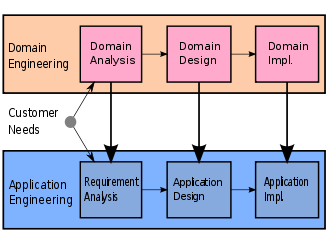Phases

Domain engineering, like application engineering, consists of three primary phases: analysis, design, and implementation. However, where software engineering focuses on a single system, domain engineering focuses on a family of systems. [7] A good domain model serves as a reference to resolve ambiguities later in the process, a repository of knowledge about the domain characteristics and definition, and a specification to developers of products which are part of the domain. [10]
Domain analysis
Domain analysis is used to define the domain, collect information about the domain, and produce a domain model. [11] Through the use of feature models (initially conceived as part of the feature-oriented domain analysis method), domain analysis aims to identify the common points in a domain and the varying points in the domain. [12] Through the use of domain analysis, the development of configurable requirements and architectures, rather than static configurations which would be produced by a traditional application engineering approach, is possible. [13]
Domain analysis is significantly different from requirements engineering, and as such, traditional approaches to deriving requirements are ineffective for development of configurable requirements as would be present in a domain model. To effectively apply domain engineering, reuse must be considered in the earlier phases of the software development life cycle. Through the use of selection of features from developed feature models, consideration of reuse of technology is performed very early and can be adequately applied throughout the development process. [14]
Domain analysis is derived primarily from artifacts produced from past experience in the domain. [11] Existing systems, their artifacts (such as design documents, requirement documents and user manuals), standards, and customers are all potential sources of domain analysis input. [11] [15] However, unlike requirements engineering, domain analysis does not solely consist of collection and formalization of information; a creative component exists as well. During the domain analysis process, engineers aim to extend knowledge of the domain beyond what is already known and to categorize the domain into similarities and differences to enhance reconfigurability. [11]
Domain analysis primarily produces a domain model, representing the common and varying properties of systems within the domain. [11] The domain model assists with the creation of architectures and components in a configurable manner by acting as a foundation upon which to design these components. [16] An effective domain model not only includes the varying and consistent features in a domain, but also defines the vocabulary used in the domain and defines concepts, ideas and phenomena, within the system. [11] [17] Feature models decompose concepts into their required and optional features to produce a fully formalized set of configurable requirements. [18]
Domain design
Domain design takes the domain model produced during the domain analysis phase and aims to produce a generic architecture to which all systems within the domain can conform. [19] In the same way that application engineering uses the functional and non-functional requirements to produce a design, the domain design phase of domain engineering takes the configurable requirements developed during the domain analysis phase and produces a configurable, standardized solution for the family of systems. Domain design aims to produce architectural patterns which solve a problem common across the systems within the domain, despite differing requirement configurations. [20] In addition to the development of patterns during domain design, engineers must also take care to identify the scope of the pattern and the level to which context is relevant to the pattern. Limitation of context is crucial: too much context results in the pattern not being applicable to many systems, and too little context results in the pattern being insufficiently powerful to be useful. [21] A useful pattern must be both frequently recurring and of high quality. [22]
The objective of domain design is to satisfy as many domain requirements as possible while retaining the flexibility offered by the developed feature model. The architecture should be sufficiently flexible to satisfy all of the systems within the domain while rigid enough to provide a solid framework upon which to base the solution. [23]
Domain implementation
Domain implementation is the creation of a process and tools for efficiently generating a customized program in the domain.



